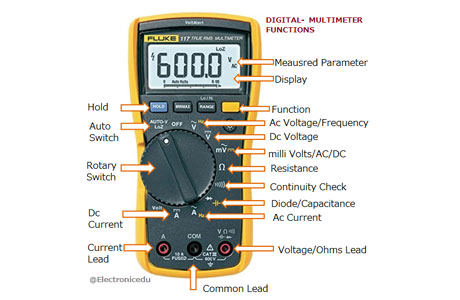What Are The Top Mistakes To Avoid When Using A Multimeter?
Key Takeaway
When using a multimeter, avoid these common mistakes to ensure accurate readings and safety. Always select the correct settings (e.g., voltage, current, resistance) on the dial before testing. Never measure resistance on a live circuit, as it can damage the multimeter or give false results. Use properly rated test leads and connect them to the correct ports, such as avoiding voltage measurements with leads in the current terminals.
Don’t exceed the multimeter’s voltage or current rating, as this can overload the device. Regularly calibrate the multimeter for accurate measurements and inspect it for damage before use. Avoid dropping the multimeter or tampering with its components. In hazardous environments, use a category-rated multimeter for safety. Lastly, always check your connections and settings before applying power to the circuit to prevent errors or damage.
Using Incorrect Settings for Measurements
One of the most frequent mistakes is selecting the wrong settings on the multimeter.
Common Errors:
Wrong Mode Selection: Setting the dial to resistance while measuring voltage or current can cause inaccurate readings or damage to the multimeter.
Incorrect Range: Using a low range for a high-voltage circuit may overload the device, while using a high range unnecessarily reduces precision.
AC/DC Confusion: Measuring DC voltage in AC mode (or vice versa) leads to false readings.
Consequences:
Risk of blown fuses or damaged internal components.
Misdiagnosis of circuit faults due to incorrect measurements.
How to Avoid:
Double-check the measurement type and range before testing.
Use auto-ranging multimeters for added convenience.
Refer to the multimeter manual for recommended settings.
Getting the settings right is a simple yet critical step that ensures accurate measurements and prevents unnecessary repairs.

Not Testing the Multimeter Before Use
Failing to verify the multimeter’s functionality before using it can lead to errors during critical measurements.
Why It Matters:
A faulty multimeter may display inaccurate readings, leading to misdiagnosis.
Broken probes or drained batteries can render the device unreliable.
Steps to Test Your Multimeter:
Check Continuity Mode: Touch the probe tips together and listen for a beep to confirm the circuit is complete.
Test Known Sources: Use a fresh battery or a live outlet to ensure the multimeter displays expected values.
Inspect Probes and Ports: Ensure the probes are securely connected and free of visible damage.
Benefits:
Early detection of issues prevents time wasted on unreliable measurements.
Regular testing keeps your multimeter in optimal working condition.
Make it a habit to test your multimeter before every use to avoid frustration and ensure dependable results.
Misplacing or Damaging Probes During Testing
The probes are your direct connection to the circuit, and improper handling can compromise safety and accuracy.
Common Mistakes:
Loose Connections: Probes not firmly inserted into the ports can cause erratic readings or arcing.
Probe Misplacement: Touching the wrong terminals can lead to short circuits or blown fuses.
Physical Damage: Cracked insulation or bent tips expose users to electrical shock and impair measurements.
Prevention Tips:
Always insert the black probe into the COM port and the red probe into the appropriate measurement port (VΩ, mA, or A).
Use probes with insulation rated for the voltage of the circuit being tested.
Inspect probes regularly and replace them if damaged.
Probes are vital components, and taking care of them ensures accurate and safe measurements every time.
Ignoring Safety Guidelines in High-Voltage Environments
Working with high-voltage circuits demands strict adherence to safety precautions. Neglecting these guidelines can lead to serious injury or damage.
Risks of Oversight:
Electric Shock: A small mistake in handling live circuits can result in severe consequences.
Device Overload: Measuring high voltage with an under-rated multimeter can destroy the device.
Fire Hazards: Short circuits caused by incorrect probe placement can spark fires.
Safety Practices:
Wear insulated gloves and stand on a non-conductive surface when working with high voltage.
Use a multimeter rated for the circuit’s voltage category (CAT III or CAT IV for industrial systems).
Double-check connections and ensure the circuit is de-energized before switching modes.
Prioritizing safety not only protects you but also preserves your multimeter for future use.
Overlooking Calibration and Maintenance Needs
Multimeters require periodic calibration and maintenance to remain accurate and functional. Ignoring this essential step can compromise their reliability.
Why Calibration Matters:
Over time, internal components like resistors and capacitors may drift, leading to inaccurate readings.
Regular calibration aligns the multimeter with known standards, ensuring precision.
Maintenance Checklist:
Replace Batteries: Low battery levels can cause erratic readings or device failure.
Inspect Ports and Probes: Ensure all connections are clean and secure.
Schedule Calibration: Calibrate the device annually or as recommended by the manufacturer.
Long-Term Benefits:
Consistent accuracy in measurements.
Extended lifespan of the multimeter, reducing replacement costs.
Neglecting maintenance may seem like a time-saver, but it ultimately leads to more frequent errors and potential equipment failure.
Conclusion
Using a multimeter effectively requires attention to detail and adherence to best practices. Avoiding mistakes like incorrect settings, faulty probes, and ignoring safety measures ensures accurate readings and a longer lifespan for your device.
For new engineers, mastering these fundamentals not only builds confidence but also ensures you’re working safely and efficiently in any electrical environment. Make a habit of following these guidelines, and your multimeter will remain a reliable tool for years to come.

